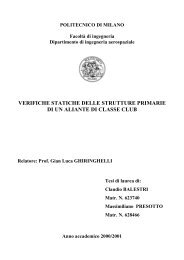Active control and drag reduction in turbulent wall flows
Active control and drag reduction in turbulent wall flows
Active control and drag reduction in turbulent wall flows
You also want an ePaper? Increase the reach of your titles
YUMPU automatically turns print PDFs into web optimized ePapers that Google loves.
Introduzione: turbolenza e <strong>control</strong>lo Problema modello e approccio Risultati e conclusioni<br />
<strong>Active</strong> <strong>control</strong> <strong>and</strong> <strong>drag</strong> <strong>reduction</strong><br />
<strong>in</strong> <strong>turbulent</strong> <strong>wall</strong> <strong>flows</strong><br />
Fulvio Mart<strong>in</strong>elli 1 Maurizio Quadrio 1 Paolo Luch<strong>in</strong>i 2<br />
(1) Dipartimento Ing. Aerospaziale, Politecnico di Milano<br />
(2) Dipartimento Ing. Meccanica, Università di Salerno<br />
CAPI 2007 - Milano<br />
15-16 Ottobre 2007<br />
university-logo<br />
Fulvio Mart<strong>in</strong>elli, Maurizio Quadrio, Paolo Luch<strong>in</strong>i DIA PoliMi<br />
<strong>Active</strong> <strong>control</strong> <strong>and</strong> <strong>drag</strong> <strong>reduction</strong> <strong>in</strong> <strong>turbulent</strong> <strong>wall</strong> <strong>flows</strong>
Introduzione: turbolenza e <strong>control</strong>lo Problema modello e approccio Risultati e conclusioni<br />
Sommario<br />
Introduzione: turbolenza e <strong>control</strong>lo<br />
Problema modello e approccio<br />
Risultati e conclusioni<br />
university-logo<br />
Fulvio Mart<strong>in</strong>elli, Maurizio Quadrio, Paolo Luch<strong>in</strong>i DIA PoliMi<br />
<strong>Active</strong> <strong>control</strong> <strong>and</strong> <strong>drag</strong> <strong>reduction</strong> <strong>in</strong> <strong>turbulent</strong> <strong>wall</strong> <strong>flows</strong>
Introduzione: turbolenza e <strong>control</strong>lo Problema modello e approccio Risultati e conclusioni<br />
Cos’è la turbolenza?<br />
university-logo<br />
Fulvio Mart<strong>in</strong>elli, Maurizio Quadrio, Paolo Luch<strong>in</strong>i DIA PoliMi<br />
<strong>Active</strong> <strong>control</strong> <strong>and</strong> <strong>drag</strong> <strong>reduction</strong> <strong>in</strong> <strong>turbulent</strong> <strong>wall</strong> <strong>flows</strong>
Introduzione: turbolenza e <strong>control</strong>lo Problema modello e approccio Risultati e conclusioni<br />
Cos’è la turbolenza?<br />
university-logo<br />
Fulvio Mart<strong>in</strong>elli, Maurizio Quadrio, Paolo Luch<strong>in</strong>i DIA PoliMi<br />
<strong>Active</strong> <strong>control</strong> <strong>and</strong> <strong>drag</strong> <strong>reduction</strong> <strong>in</strong> <strong>turbulent</strong> <strong>wall</strong> <strong>flows</strong>
Introduzione: turbolenza e <strong>control</strong>lo Problema modello e approccio Risultati e conclusioni<br />
Caratteristiche dei flussi turbolenti<br />
◮ Assenza di separazione delle scale<br />
◮ Tridimensionalità<br />
◮ Non stazionarietà<br />
◮ D<strong>in</strong>amica caotica<br />
university-logo<br />
Fulvio Mart<strong>in</strong>elli, Maurizio Quadrio, Paolo Luch<strong>in</strong>i DIA PoliMi<br />
<strong>Active</strong> <strong>control</strong> <strong>and</strong> <strong>drag</strong> <strong>reduction</strong> <strong>in</strong> <strong>turbulent</strong> <strong>wall</strong> <strong>flows</strong>
Introduzione: turbolenza e <strong>control</strong>lo Problema modello e approccio Risultati e conclusioni<br />
Turbolenza e tecnologia<br />
I flussi turbolenti sono dovunque!<br />
◮ Flusso d’aria su aeroplani, automobili, motocicli,<br />
imbarcazioni<br />
◮ Flusso d’acqua su sottomar<strong>in</strong>i, imbarcazioni<br />
◮ Processi di combustione<br />
◮ Oleodotti e gasdotti<br />
◮ Flusso nei vasi sanguigni e nelle alte vie respiratorie<br />
◮ Atmosfera<br />
university-logo<br />
Fulvio Mart<strong>in</strong>elli, Maurizio Quadrio, Paolo Luch<strong>in</strong>i DIA PoliMi<br />
<strong>Active</strong> <strong>control</strong> <strong>and</strong> <strong>drag</strong> <strong>reduction</strong> <strong>in</strong> <strong>turbulent</strong> <strong>wall</strong> <strong>flows</strong>
Introduzione: turbolenza e <strong>control</strong>lo Problema modello e approccio Risultati e conclusioni<br />
Turbolenza di parete<br />
Tutti i flussi di <strong>in</strong>teresse applicativo si sviluppano vic<strong>in</strong>o a corpi<br />
solidi (pareti).<br />
La presenza della parete è il motore della turbolenza. È<br />
fondamentale studiare la d<strong>in</strong>amica dei flussi turbolenti <strong>in</strong><br />
prossimità di pareti solide.<br />
university-logo<br />
Fulvio Mart<strong>in</strong>elli, Maurizio Quadrio, Paolo Luch<strong>in</strong>i DIA PoliMi<br />
<strong>Active</strong> <strong>control</strong> <strong>and</strong> <strong>drag</strong> <strong>reduction</strong> <strong>in</strong> <strong>turbulent</strong> <strong>wall</strong> <strong>flows</strong>
Introduzione: turbolenza e <strong>control</strong>lo Problema modello e approccio Risultati e conclusioni<br />
Controllo della turbolenza<br />
Perché?<br />
◮ Riduzione dei consumi nei trasporti aerei e mar<strong>in</strong>i<br />
◮ Riduzione di emissioni <strong>in</strong>qu<strong>in</strong>anti nei processi di<br />
combustione<br />
◮ Aumento dell’efficienza <strong>in</strong> processi <strong>in</strong>dustriali e<br />
farmaceutici<br />
university-logo<br />
Fulvio Mart<strong>in</strong>elli, Maurizio Quadrio, Paolo Luch<strong>in</strong>i DIA PoliMi<br />
<strong>Active</strong> <strong>control</strong> <strong>and</strong> <strong>drag</strong> <strong>reduction</strong> <strong>in</strong> <strong>turbulent</strong> <strong>wall</strong> <strong>flows</strong>
Introduzione: turbolenza e <strong>control</strong>lo Problema modello e approccio Risultati e conclusioni<br />
Ne vale la pena?<br />
Un esempio: aereo da trasporto civile<br />
◮ Riduzione del 10% della resistenza = aumento del 40% del<br />
marg<strong>in</strong>e di profitto della compagnia aerea.<br />
◮ Consider<strong>and</strong>o l’<strong>in</strong>tera flotta civile mondiale: risparmio di ≈<br />
7 miliardi di dollari/anno<br />
Fonti: Scientific American (1997) & U.S. National Committee on<br />
Theoretical <strong>and</strong> Applied Mechanics, 2006<br />
university-logo<br />
Fulvio Mart<strong>in</strong>elli, Maurizio Quadrio, Paolo Luch<strong>in</strong>i DIA PoliMi<br />
<strong>Active</strong> <strong>control</strong> <strong>and</strong> <strong>drag</strong> <strong>reduction</strong> <strong>in</strong> <strong>turbulent</strong> <strong>wall</strong> <strong>flows</strong>
Introduzione: turbolenza e <strong>control</strong>lo Problema modello e approccio Risultati e conclusioni<br />
Controllo della turbolenza<br />
Tecniche passive<br />
◮ Non richiede <strong>in</strong>gresso di<br />
energia nel sistema<br />
◮ Tipicamente: progetto<br />
appropriato di forme e<br />
superfici<br />
university-logo<br />
Fulvio Mart<strong>in</strong>elli, Maurizio Quadrio, Paolo Luch<strong>in</strong>i DIA PoliMi<br />
<strong>Active</strong> <strong>control</strong> <strong>and</strong> <strong>drag</strong> <strong>reduction</strong> <strong>in</strong> <strong>turbulent</strong> <strong>wall</strong> <strong>flows</strong>
Introduzione: turbolenza e <strong>control</strong>lo Problema modello e approccio Risultati e conclusioni<br />
Controllo della turbolenza<br />
Tecniche attive <strong>in</strong> anello aperto<br />
◮ Richiedono una spesa energetica (attuatori)<br />
◮ Esempio: aspirazione dello strato limite su profili alari<br />
university-logo<br />
Fulvio Mart<strong>in</strong>elli, Maurizio Quadrio, Paolo Luch<strong>in</strong>i DIA PoliMi<br />
<strong>Active</strong> <strong>control</strong> <strong>and</strong> <strong>drag</strong> <strong>reduction</strong> <strong>in</strong> <strong>turbulent</strong> <strong>wall</strong> <strong>flows</strong>
Introduzione: turbolenza e <strong>control</strong>lo Problema modello e approccio Risultati e conclusioni<br />
Controllo della turbolenza<br />
Tecniche attive <strong>in</strong> retroazione<br />
◮ Richiedono una spesa energetica (attuatori)<br />
◮ Richiedono misure (sensori)<br />
◮ Richiedono una legge di <strong>control</strong>lo<br />
◮ Esempio: soffiamento - aspirazione a parete sulla base di<br />
misure di attrito<br />
university-logo<br />
Fulvio Mart<strong>in</strong>elli, Maurizio Quadrio, Paolo Luch<strong>in</strong>i DIA PoliMi<br />
<strong>Active</strong> <strong>control</strong> <strong>and</strong> <strong>drag</strong> <strong>reduction</strong> <strong>in</strong> <strong>turbulent</strong> <strong>wall</strong> <strong>flows</strong>
Introduzione: turbolenza e <strong>control</strong>lo Problema modello e approccio Risultati e conclusioni<br />
Controllo <strong>in</strong> retroazione di flussi turbolenti<br />
U<br />
flow channel<br />
u y<br />
k(t,x,z)<br />
actuators<br />
sensors<br />
<strong>control</strong> kernel<br />
U<br />
university-logo<br />
Fulvio Mart<strong>in</strong>elli, Maurizio Quadrio, Paolo Luch<strong>in</strong>i DIA PoliMi<br />
<strong>Active</strong> <strong>control</strong> <strong>and</strong> <strong>drag</strong> <strong>reduction</strong> <strong>in</strong> <strong>turbulent</strong> <strong>wall</strong> <strong>flows</strong>
Introduzione: turbolenza e <strong>control</strong>lo Problema modello e approccio Risultati e conclusioni<br />
Stato dell’arte<br />
◮ Approccio esclusivamente computazionale<br />
◮ Soluzione numerica diretta delle equazioni di<br />
Navier-Stokes (no modelli di turbolenza!)<br />
◮ Utilizzo della teoria del <strong>control</strong>lo ottimo (sviluppata<br />
nell’ambito della meccanica e dell’elettronica)<br />
Gruppi di ricerca co<strong>in</strong>volti:<br />
◮ Politecnico di Milano - Università di Salerno (Prof. M.<br />
Quadrio, Prof. P. Luch<strong>in</strong>i)<br />
◮ University of California, San Diego (Prof. T. Bewley)<br />
university-logo<br />
Fulvio Mart<strong>in</strong>elli, Maurizio Quadrio, Paolo Luch<strong>in</strong>i DIA PoliMi<br />
<strong>Active</strong> <strong>control</strong> <strong>and</strong> <strong>drag</strong> <strong>reduction</strong> <strong>in</strong> <strong>turbulent</strong> <strong>wall</strong> <strong>flows</strong>
Introduzione: turbolenza e <strong>control</strong>lo Problema modello e approccio Risultati e conclusioni<br />
Simulazione numerica diretta (DNS) della turbolenza<br />
di parete<br />
◮ Problema modello: flusso turbolento fra due lastre piane<br />
◮ Geometria semplice: simulazioni accurate a Reynolds<br />
moderati<br />
◮ Nessun modello di turbolenza: cent<strong>in</strong>aia di milioni di gradi<br />
di libertà<br />
◮ Formulazione: Quadrio & Luch<strong>in</strong>i (JCP, 2006)<br />
university-logo<br />
Fulvio Mart<strong>in</strong>elli, Maurizio Quadrio, Paolo Luch<strong>in</strong>i DIA PoliMi<br />
<strong>Active</strong> <strong>control</strong> <strong>and</strong> <strong>drag</strong> <strong>reduction</strong> <strong>in</strong> <strong>turbulent</strong> <strong>wall</strong> <strong>flows</strong>
Introduzione: turbolenza e <strong>control</strong>lo Problema modello e approccio Risultati e conclusioni<br />
Progetto dei sistemi di <strong>control</strong>lo<br />
◮ Tecnica di <strong>control</strong>lo: soffiamento-aspirazione a parete<br />
◮ Progetto: basato sulla teoria del <strong>control</strong>lo ottimo l<strong>in</strong>eare<br />
◮ Anche il progetto del <strong>control</strong>lore richiede supercomputers!<br />
university-logo<br />
Fulvio Mart<strong>in</strong>elli, Maurizio Quadrio, Paolo Luch<strong>in</strong>i DIA PoliMi<br />
<strong>Active</strong> <strong>control</strong> <strong>and</strong> <strong>drag</strong> <strong>reduction</strong> <strong>in</strong> <strong>turbulent</strong> <strong>wall</strong> <strong>flows</strong>
Introduzione: turbolenza e <strong>control</strong>lo Problema modello e approccio Risultati e conclusioni<br />
Personal Supercomputer<br />
◮ Cluster ottimizzato per la<br />
DNS nel canale piano e<br />
nel tubo circolare<br />
◮ 268 dual-CPU dual-core<br />
processori AMD Opteron<br />
◮ Network<strong>in</strong>g hardare<br />
economico da 1 Gb<br />
◮ 300 GB di memoria<br />
complessiva<br />
◮ 40 TB di spazio disco<br />
◮ Potenza di picco: 2.6<br />
TFlops<br />
university-logo<br />
Fulvio Mart<strong>in</strong>elli, Maurizio Quadrio, Paolo Luch<strong>in</strong>i DIA PoliMi<br />
<strong>Active</strong> <strong>control</strong> <strong>and</strong> <strong>drag</strong> <strong>reduction</strong> <strong>in</strong> <strong>turbulent</strong> <strong>wall</strong> <strong>flows</strong>
Introduzione: turbolenza e <strong>control</strong>lo Problema modello e approccio Risultati e conclusioni<br />
Personal Supercomputer<br />
university-logo<br />
Fulvio Mart<strong>in</strong>elli, Maurizio Quadrio, Paolo Luch<strong>in</strong>i DIA PoliMi<br />
<strong>Active</strong> <strong>control</strong> <strong>and</strong> <strong>drag</strong> <strong>reduction</strong> <strong>in</strong> <strong>turbulent</strong> <strong>wall</strong> <strong>flows</strong>
Introduzione: turbolenza e <strong>control</strong>lo Problema modello e approccio Risultati e conclusioni<br />
Personal Supercomputer<br />
Confronto alternativo<br />
. Earth Simulator Personal Supercomputer<br />
Efficienza energetica 3 Flops/Watt 70 Flops/Watt<br />
Efficienza economica 1 MFlops / euro 10 MFlops / euro<br />
university-logo<br />
Fulvio Mart<strong>in</strong>elli, Maurizio Quadrio, Paolo Luch<strong>in</strong>i DIA PoliMi<br />
<strong>Active</strong> <strong>control</strong> <strong>and</strong> <strong>drag</strong> <strong>reduction</strong> <strong>in</strong> <strong>turbulent</strong> <strong>wall</strong> <strong>flows</strong>
Introduzione: turbolenza e <strong>control</strong>lo Problema modello e approccio Risultati e conclusioni<br />
Simulazioni effettuate<br />
Controllo di tipo full-state<br />
Re N<br />
2200 ≈ 10 6<br />
5000 ≈ 10 7<br />
10500 ≈ 10 8<br />
university-logo<br />
Fulvio Mart<strong>in</strong>elli, Maurizio Quadrio, Paolo Luch<strong>in</strong>i DIA PoliMi<br />
<strong>Active</strong> <strong>control</strong> <strong>and</strong> <strong>drag</strong> <strong>reduction</strong> <strong>in</strong> <strong>turbulent</strong> <strong>wall</strong> <strong>flows</strong>
Introduzione: turbolenza e <strong>control</strong>lo Problema modello e approccio Risultati e conclusioni<br />
Progetto del <strong>control</strong>lore<br />
Nucleo di convoluzione<br />
university-logo<br />
Fulvio Mart<strong>in</strong>elli, Maurizio Quadrio, Paolo Luch<strong>in</strong>i DIA PoliMi<br />
<strong>Active</strong> <strong>control</strong> <strong>and</strong> <strong>drag</strong> <strong>reduction</strong> <strong>in</strong> <strong>turbulent</strong> <strong>wall</strong> <strong>flows</strong>
Introduzione: turbolenza e <strong>control</strong>lo Problema modello e approccio Risultati e conclusioni<br />
Effetto del <strong>control</strong>lo sulle strutture turbolente<br />
university-logo<br />
Fulvio Mart<strong>in</strong>elli, Maurizio Quadrio, Paolo Luch<strong>in</strong>i DIA PoliMi<br />
<strong>Active</strong> <strong>control</strong> <strong>and</strong> <strong>drag</strong> <strong>reduction</strong> <strong>in</strong> <strong>turbulent</strong> <strong>wall</strong> <strong>flows</strong>
Introduzione: turbolenza e <strong>control</strong>lo Problema modello e approccio Risultati e conclusioni<br />
Riduzione della resistenza<br />
τ con / τ ref<br />
1.5<br />
1<br />
0.5<br />
Re = 2200<br />
Re = 5000<br />
Re = 10500<br />
0<br />
0 50 100 150<br />
t<br />
university-logo<br />
Fulvio Mart<strong>in</strong>elli, Maurizio Quadrio, Paolo Luch<strong>in</strong>i DIA PoliMi<br />
<strong>Active</strong> <strong>control</strong> <strong>and</strong> <strong>drag</strong> <strong>reduction</strong> <strong>in</strong> <strong>turbulent</strong> <strong>wall</strong> <strong>flows</strong>
Introduzione: turbolenza e <strong>control</strong>lo Problema modello e approccio Risultati e conclusioni<br />
Riduzione dell’energia c<strong>in</strong>etica turbolenta<br />
E con / E ref<br />
1.5<br />
1<br />
0.5<br />
Re = 2200<br />
Re = 5000<br />
Re = 10500<br />
0<br />
0 50 100 150<br />
t<br />
university-logo<br />
Fulvio Mart<strong>in</strong>elli, Maurizio Quadrio, Paolo Luch<strong>in</strong>i DIA PoliMi<br />
<strong>Active</strong> <strong>control</strong> <strong>and</strong> <strong>drag</strong> <strong>reduction</strong> <strong>in</strong> <strong>turbulent</strong> <strong>wall</strong> <strong>flows</strong>
Introduzione: turbolenza e <strong>control</strong>lo Problema modello e approccio Risultati e conclusioni<br />
Effetto Re<br />
% Reduction<br />
50<br />
45<br />
40<br />
35<br />
30<br />
25<br />
Drag<br />
Energy<br />
20<br />
2000 4000 6000 8000 10000 12000<br />
Re<br />
university-logo<br />
Fulvio Mart<strong>in</strong>elli, Maurizio Quadrio, Paolo Luch<strong>in</strong>i DIA PoliMi<br />
<strong>Active</strong> <strong>control</strong> <strong>and</strong> <strong>drag</strong> <strong>reduction</strong> <strong>in</strong> <strong>turbulent</strong> <strong>wall</strong> <strong>flows</strong>
Introduzione: turbolenza e <strong>control</strong>lo Problema modello e approccio Risultati e conclusioni<br />
Conclusioni e prospettive<br />
◮ Interesse <strong>in</strong>gegneristico nel <strong>control</strong>lo di flussi turbolenti<br />
◮ Il <strong>control</strong>lo attivo <strong>in</strong> retroazione è una tecnica promettente<br />
◮ Le prestazioni sono buone anche a Re moderati<br />
◮ Necessità (oggi) di supercalcolatori<br />
◮ Domani?<br />
university-logo<br />
Fulvio Mart<strong>in</strong>elli, Maurizio Quadrio, Paolo Luch<strong>in</strong>i DIA PoliMi<br />
<strong>Active</strong> <strong>control</strong> <strong>and</strong> <strong>drag</strong> <strong>reduction</strong> <strong>in</strong> <strong>turbulent</strong> <strong>wall</strong> <strong>flows</strong>


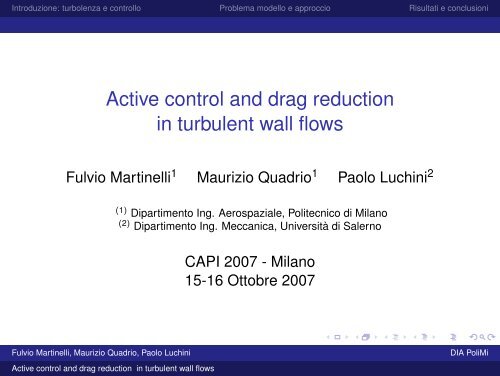
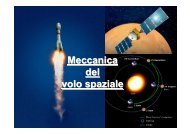
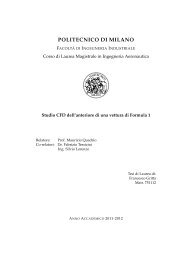
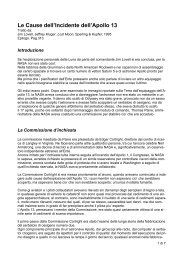
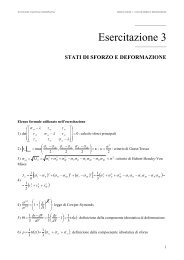
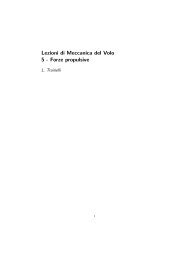

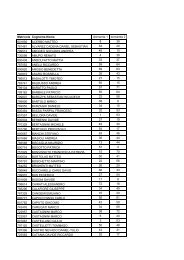
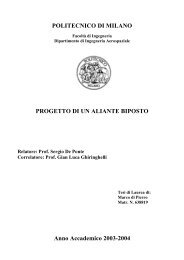
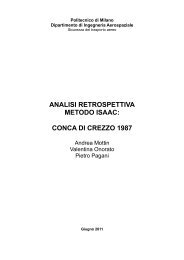
![[12.06.12] Coordinamento di Aeroporto 2012](https://img.yumpu.com/16337305/1/190x143/120612-coordinamento-di-aeroporto-2012.jpg?quality=85)
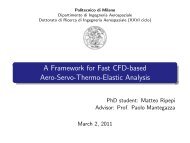
![[11.06.10] Lo strato limite turbolento](https://img.yumpu.com/16319523/1/184x260/110610-lo-strato-limite-turbolento.jpg?quality=85)
